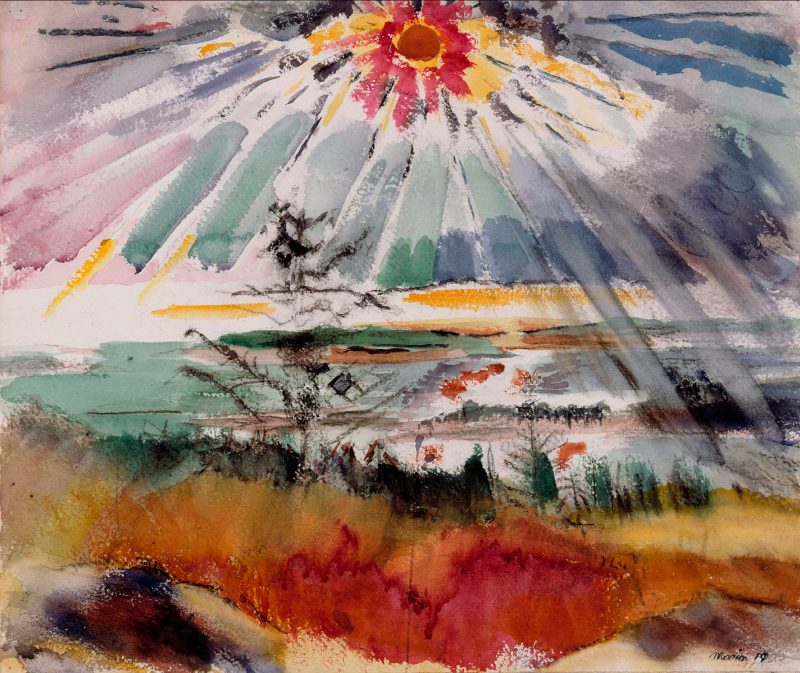
Sunset, Casco Bay
Marin, John
1919
Artwork Information
-
Title:
Sunset, Casco Bay
-
Artist:
Marin, John
-
Artist Bio:
American, 1870–1953
-
Date:
1919
-
Medium:
Watercolor and charcoal on paper
-
Dimensions:
16 1/4 x 19 1/2 in.
-
Credit Line:
Wichita Art Museum, Roland P. Murdock Collection, Gift of Georgia O'Keeffe
-
Object Number:
M147.57
-
Display:
Not Currently on Display
About the Artwork
John Marin drew inspiration for distinctive watercolors like Sunset, Casco Bay from the Maine landscape. Born in Rutherford, New Jersey, Marin began a career as an architect in the early 1890s before deciding to study art, first at the Pennsylvania Academy of the Fine Arts from 1899-1901, then at the Art Students League in New York City from 1902-03. From 1905–10, Marin traveled extensively in Europe, where he produced etchings and painted watercolors. He returned to New York City and, in 1914, began to spend his summers in Maine along the Atlantic coast. This seasonal hiatus from the syncopation of modern life in New York City, the subject of his watercolors from 1912–14, proved pivotal to Marin’s refinement of subject matter and style. In Maine, Marin explored transient effects of light on the sea and landscape. His imagination was endlessly stimulated by the kaleidoscopic colors, variegated forms, and passing atmospheric conditions.
Working on the Maine coast in the summer of 1919, Marin executed two versions of Sunset, Casco Bay One of them he kept while the other, now in Wichita, was owned by Georgia O’Keeffe.1 In the Wichita watercolor, the sun bursts into a radiant spectrum of color—greens, blue-violets, and reddish orange washes. These vivid notes of color, originating in the sunburst, are recapitulated throughout the composition. The vibrant, pulsing red that defines the orb of the sun spreads through both the sky and the foreground shore, where it blends in a rich wash heightened by orange and yellow. Green, in both sun ray and sea water, appears in multiple registers of the composition and ultimately defines the coniferous tree line before the expanse of water. Water catches the suns hues as reddish-orange highlights in dappled waves. Sensuous blue-violet fingers reach down to touch the earth, their pigment dragged by the brush in long, wet strokes. Black lines, dryly brushed, delineate forms and zones of pure color. The bay, spread out beneath an elevated vantage point, offers a dramatic panorama before the sunset’s brilliance.
Marin links the planes of sky and land, not only by his use of color, but in his summary treatment of foreground elements. Near the center of the composition a lone tree rises from the foreground. Its skeletal form, executed in brisk, dry strokes of black, reaches up into the sky to meet the pulsating rhythms of color. Equally abbreviated is the arm of a distant shore, sketched in to create only an abstract sense of the land rather than a concrete presence. Despite such use of broad washes and sketchy strokes, Marin also includes the specific in his translation of light setting over cove. In the immediate foreground, he articulates individual blades of grass with dry strokes laid over wash. In these contrasts between the general and the specific, Marin creates a parallel tension to heighten the friction between flattened foreground and suggested spatial recession into the background plane. Such tensions reveal Marin’s interest in modern abstraction; yet, his subject matter and style remain the artist’s own highly personal expression.
1. Cf. cat. nos. 19.39 and 19.40 in Sheldon Reich, John Marin, Part II: Catalogue Raisonné (Tucson: University of Arizona Press, 1970), 473-74. On p. 474 see also cat. no. 19.41, Sunset, Maine Coast (Columbus Museum of Art), from the same year, which features a similar composition albeit with the sun sinking below the horizon and casting its rays up into the sky rather than down onto the sea, as it does in the two versions of Sunset, Casco Bay.